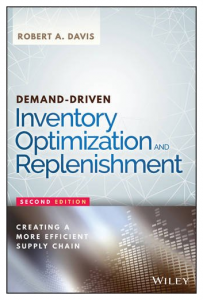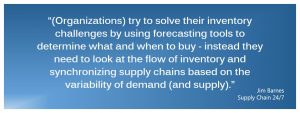Inventory is a result of decisions. Inventory is not the problem... the problem is the decisions.
I recently had an interesting conversation with the VP, Supply Chain at a leading global manufacturer. He is not happy with the results from the inventory optimization he is using. He was told inventory optimization would revolutionize his supply chain and right size his system. He had gotten some small, incremental improvements, but nowhere near what was promised. I simply asked him if he made any changes on the way his team made supply chain decisions. Here is what he said, “We have inventory optimization. It's supposed to correct supply chain mistakes!"
I've run into this perception all too often. Inventory optimization has been sold as a miracle drug with the ability to cure everything. I’m proud to say that the inventory optimization installs that I have been involved with have a high success rate and have been working for many years. Why? Simply put - we not only sold inventory optimization as an inventory management methodology, but more importantly, we helped the client understand where they were making bad supply chain decisions!
Write a book, they said
After spending the better part of ten years working in inventory optimization I finally wrote a book, Demand Driven Inventory Optimization and Replenishment. Published by Wiley & Son, the success of the book led to the need for a 2nd edition, now available at Amazon Books.
 I’m often asked why I would write a book on such a mundane subject. It would seem that the subject had been covered by many in academia and industry. Indeed, if you Google the subject you will see many PhD thesis papers created to support the various algorithms used to deliver single, dual and multi-echelon solutions. However, the other thing you will find is a "Marketing Jungle" filled with empty promises. The thing I found when I was researching the subject in 2003 (and continue to see today) was that for every thoughtful paper written explaining how the math works, there are hundreds of marketing claims of pots of gold at the end of the every supply chain rainbow.
I’m often asked why I would write a book on such a mundane subject. It would seem that the subject had been covered by many in academia and industry. Indeed, if you Google the subject you will see many PhD thesis papers created to support the various algorithms used to deliver single, dual and multi-echelon solutions. However, the other thing you will find is a "Marketing Jungle" filled with empty promises. The thing I found when I was researching the subject in 2003 (and continue to see today) was that for every thoughtful paper written explaining how the math works, there are hundreds of marketing claims of pots of gold at the end of the every supply chain rainbow.
From 2002 to 2012 inventory optimization was going to solve every supply chain illness known to man. If inventory was sitting somewhere in your organization, optimization was going to make it perfect! If you made an ill-advised decision and produced 20 times more inventory than required for an obviously slow moving new product, then inventory optimization was going to some how get rid of the excess stock. If you stored all of your inventory as a finished product and did not practice any postponement activities, inventory optimization was going to tell you when to put labels on your Christmas CD’s. If you were an OEM auto part supplier who was suddenly sitting with six years of obsolete inventory due to a downturn in the economy, inventory optimization was going to solve the problem of your cash flow issues. The list of problems that would suddenly go away with inventory optimization were endless.
Somewhere the line between inventory optimization and supply chain decisions got blurred. I put the blame on an overzealous industry and their marketing departments. Inventory optimization wasn’t just in a hype cycle... it was in the hype stratosphere. This is where I found the inventory optimization topic in 2003. For some reason executives where being told inventory optimization’s algorithms could automatically overcome poor decision making. For the next ten twelve years, when I would present inventory optimization to executives, it was obvious they didn’t understand what inventory optimization was and how it worked in the supply chain. At that point I felt someone needed to tell the truth about inventory optimization fundamentals. Someone needed to point the conversation directly at executives who would make decisions about purchasing supply chain solutions.
A few basics:
1. What does Inventory Optimization do?
Calculates optimal inventory levels and policies throughout the entire supply chain based on cost, time and lot size constraints.
2. Why is Inventory Optimization important?
It closes the gaps in analytics that are hard coded into your ERP/SCM systems since the 1990s. You can develop better distribution strategies and base decisions on information across the network when your inventory is looked at holistically.
3. For whom is Inventory Optimization intended?
The Inventory Optimization workflow is designed to allow inventory control managers the ability to use optimized, network inventory positions in their product distribution planning. Optimized inventory positions and orders suggestions allow the buyer/planner more time to focus on strategic planning activities.
The Hard Truth About Inventory Optimization
I've never met Jim Barnes, but I look forward to the day I do because I want to shake the hand of a man who totally gets it. If used correctly, inventory optimization will help align and synchronize the supply chain to react to the variability of demand and supply. However, the key to the solution is that through scenario analysis you can measure the benefit of changing the way your supply chain works. For instance, a simple change in lead-time through the use of LTL trucks on slower moving SKUs can dramatically alter your inventory position. Even though the SKU might have a slightly higher unit cost, the savings of inventory and the agility created far out weights the cost. Testing supply chain decisions using inventory optimization is a great way to develop strategies, but it doesn't occur automatically. Without inventory optimization, you are stuck reacting to backward looking KPI's, like driving through a review mirror. This whipsaw process throws supply chains back and forth between efficiency (inventory turns) and effectiveness (operating margin).
How can my book help supply chain leaders?
The book is set up in phases to help executives understand how we have gotten to this point where present inventory management techniques don’t work. Through analysis of case studies, installation and evaluation processes the reader can learn from the mistakes of others and see a pathway to a successful inventory optimization engagement.
1. Forget about what's better, a push and pull supply chain simple denotes a make to store and a make to order techniques.
Let’s get beyond the buzz words! The concept of a so-called "pull" supply chain as it is defined in today’s environment is to react in an agile fashion to changes in demand. Demand latency, or the time it takes for you to fully grasp the true demand shift, is your enemy. It is the reason the bullwhip effect is so huge at the top-end of the supply chain.
2. What are the shortcomings built into your ERP system that are causing you to make bad inventory decisions?
Due to the way transactional ERP systems are built they can’t efficiently develop “calculated tables.” Therefore, they can't look at broad arrays of options between links in the supply chain. To overcome this shortcuts known as single stage calculations or sequential optimization are developed to provide outputs. This island of efficiency technique makes everyone try to push inventory onto trading partners instead of truly reducing the stock levels.
3. The use of backward looking KPI’s increases the amount of time between seeing a change and reacting to it.
This increase in reaction time creates massive swings in inventory and makes the inventory either too much or too little. Indeed, this is where we find what is known as “The Goldilocks’ Effect.” That's where 70% of inventory tends to be over-stocked, 20% of the inventory under-stocked and 10% of inventory is just right.
4. What will inventory optimization do and how does it do it?
In a simplistic fashion you are shown the steps of how inventory optimization works and what processes are positioned to create results from a single, dual and multi-echelon optimization routine. The outputs of IO aren’t very sexy, but the ability to upload them into an ERP system so it runs better can have a positive effect and increase the efficiency of that expensive piece of software.
5. What can you expect if you were going to perform a “Proof of Value” engagement?
You are going to see the good, the bad, and the ugly when it comes to working with POV’s. However, this is where executives begin to see where the problems lie in their company. There will be a lot of turf protection and you get to see where bad decisions are occurring. This is where the strong executive needs to steer the ship through treacherous waters.
6. Looking at a real world inventory optimization installation and the steps it took to be successful.
Successful installations don’t just happen. There are setbacks and “ah ha” moments. You will be walked through the installation and see - through the eyes of the team - where they need both diligence and insight. This is a big learning experience for everyone involved.
7. What can be expected depending on your position in the supply chain?
Depending on where your industry resides in the supply chain, you can expect to achieve different results. Retail tends to have the shortest reaction time to actual demand. Often, they will benefit directly in increased sales when they make their DC’s into actual inventory buffers instead of transfer locations. In turn, manufacturers can expect massive reductions in redundant inventory. Executives can now understand the real benefits for their opportunity and not just listen to a snake oil sales pitch.
I wrote “Demand Driven Inventory Optimization and Replenishment” for the executive looking to get beyond the empty promises of the last fifteen years. Inventory optimization is a management methodology based on mathematical processes to counteract human reactions to changes in demand. While it is more than a way to calculate safety stocks, it is not the wonder pill promised by overblown marketing departments. Supply chains have to be managed in a way that strategies are undertaken can make inventory more efficient - not just push it around. Moreover, inventory optimization will not help if supply planners continue doing what they have done in the past. Management needs to be ready to implement process change as the inventory optimization install occurs. As I said before, IO is not going to negate poor decisions!
In the end, the goal in writing the book was to help executives look at the whole picture when evaluating inventory optimization as a potential solution. The most successful installations I have been involved with, were successful when the solution dovetailed with a willingness to drive efficient and effective decision making in the supply chain. At that point the savvy supply chain executive will attain the agility they were looking for.


1 Comment
Hey bob, Fantastic post!
Inventory optimization has never been easy.From my experience, I can say that preparation of inventory budgets is very important for your business. Many organization have an annual inventory budget and they are usually prepared well in advance before inventory is procured. Budgets should include the total cost of ownership to keep inventory on hand during that year's account period.